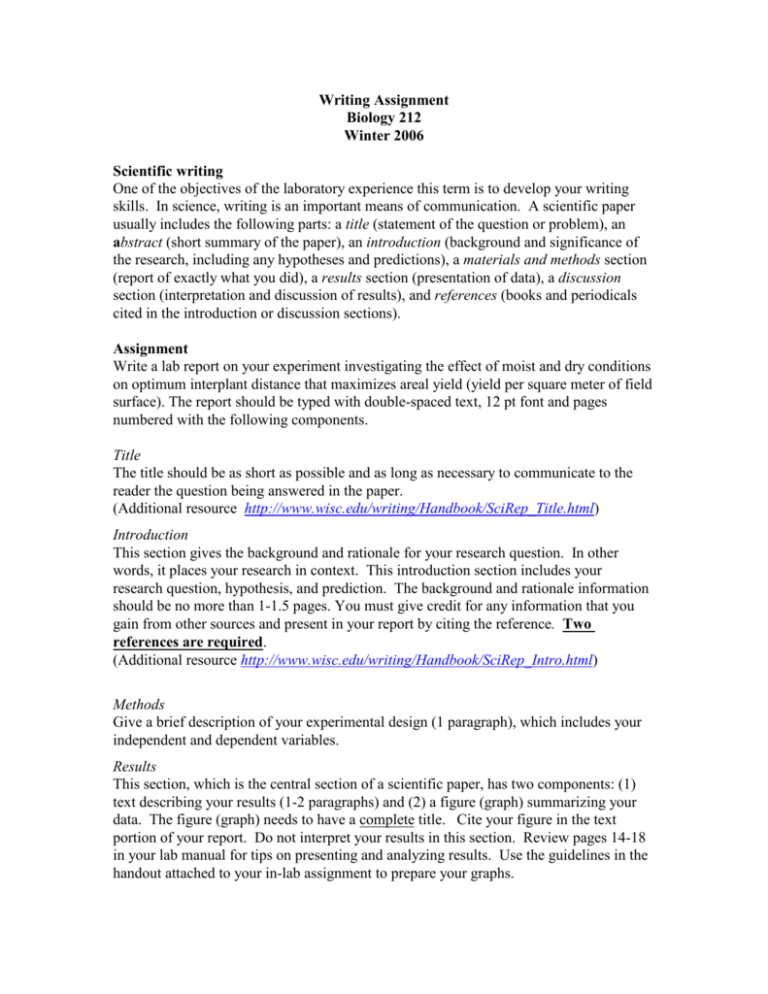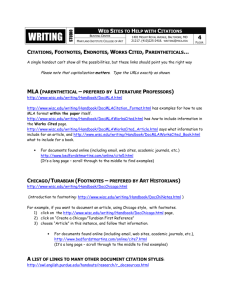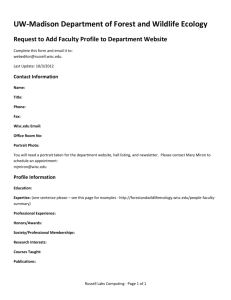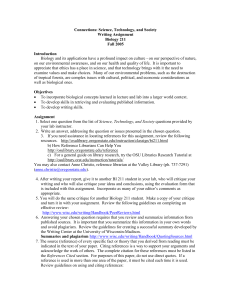Lab Report on Photosynthesis
advertisement

Writing Assignment Biology 212 Winter 2006 Scientific writing One of the objectives of the laboratory experience this term is to develop your writing skills. In science, writing is an important means of communication. A scientific paper usually includes the following parts: a title (statement of the question or problem), an abstract (short summary of the paper), an introduction (background and significance of the research, including any hypotheses and predictions), a materials and methods section (report of exactly what you did), a results section (presentation of data), a discussion section (interpretation and discussion of results), and references (books and periodicals cited in the introduction or discussion sections). Assignment Write a lab report on your experiment investigating the effect of moist and dry conditions on optimum interplant distance that maximizes areal yield (yield per square meter of field surface). The report should be typed with double-spaced text, 12 pt font and pages numbered with the following components. Title The title should be as short as possible and as long as necessary to communicate to the reader the question being answered in the paper. (Additional resource http://www.wisc.edu/writing/Handbook/SciRep_Title.html) Introduction This section gives the background and rationale for your research question. In other words, it places your research in context. This introduction section includes your research question, hypothesis, and prediction. The background and rationale information should be no more than 1-1.5 pages. You must give credit for any information that you gain from other sources and present in your report by citing the reference. Two references are required. (Additional resource http://www.wisc.edu/writing/Handbook/SciRep_Intro.html) Methods Give a brief description of your experimental design (1 paragraph), which includes your independent and dependent variables. Results This section, which is the central section of a scientific paper, has two components: (1) text describing your results (1-2 paragraphs) and (2) a figure (graph) summarizing your data. The figure (graph) needs to have a complete title. Cite your figure in the text portion of your report. Do not interpret your results in this section. Review pages 14-18 in your lab manual for tips on presenting and analyzing results. Use the guidelines in the handout attached to your in-lab assignment to prepare your graphs. Discussion (Additional resource http://www.wisc.edu/writing/Handbook/SciRep_Disc.html) In this section, you will analyze and interpret the results of your experiment. Use the following guidelines from your lab manual Appendix A: “Simply restating the results is not interpretation. The Discussion must provide a context for understanding the significance of the results. Explain why you observed these results and how these results contribute to our knowledge. Your results will support or confirm your hypothesis or will negate, refute or contradict your hypothesis but the word “prove” is not appropriate in scientific writing. If you results do not support your hypothesis, you must still state why you think this occurred. Support your ideas from other work (book, lectures or outside reading of scientific literature). State your conclusions in this section. “Complete your Introduction and Results sections before you begin writing the Discussion. The figures and tables in the Results section will be particularly important as you begin to think about your discussion. The graphs allow you to visualize the effects that the independent variables had on the dependent variables in your experiment. Studying these data will be one of the first steps in interpreting your results. As you study the information in the introduction section and your data in the Results section, write down relationships and integrate these relationships into a rough draft of your discussion. “The following steps may be helpful as you begin to outline your discussion and before you write the narrative: Restate your question, hypothesis, and prediction. Write down the specific data, including results of statistical tests. State whether your results did or did not confirm your prediction and support or negate your hypothesis. Write down what you know about the biology involved in your experiment. How do your results fit in with what you know? What is the significance of your results? How do your results support or conflict with previous work? Include references to this work. Clearly state your conclusions. You are now ready to write the narrative for the Discussion. Integrate all of the above information into several simple, clear, concise paragraphs. Discuss the results; do no simply restate the data. Refer to other work to support your ideas”. References You must give credit to any information that you gain from other sources and that you present in your report. At least two references are required. See resources below for guidelines on citing references. References need to be listed in alphabetical order by author’s last name. No references from the Internet will be accepted for this assignment unless from an online peer reviewed scientific journal. How to decide what information must be referenced http://www.wisc.edu/writing/Handbook/QPA_plagiarism.html How to write a successful summary without plagiarizing http://www.wisc.edu/writing/Handbook/QuotingSources.html http://www.wisc.edu/writing/Handbook/QuotingSources.html How to cite references http://www.wisc.edu/writing/Handbook/DocCBE_NameYear_Intext.html http://www.wisc.edu/writing/Handbook/DocCBE_NameYear_RefList.html Additional Resources The Biology web site, http://osu.orst.edu/instruct/bi212/writew06.htm, has information on resources for writing and library research. General information on writing a scientific report Appendix A Scientific Writing in your lab manual. Evaluation form included with this assignment sheet. Be sure to talk with your Lab Instructor if you have any questions. Due Date Your Lab Instructor will assign the due date. The grade on late reports will decrease 5% per day. Format Evaluation Your lab report will be evaluated on the content (4 points) and the effectiveness of your communication, including text and figures (5 points). See the attached page for a sample evaluation form. Evaluation of Lab Report on Photosynthesis Biology 212 Winter 2006 CONTENT Title Introduction Background and rationale Research question Hypothesis Prediction Methods Description of experimental design Procedures Results Table or figure (graph) Text describing results Discussion COMMUNICATION Writing Grammar, spelling, punctuation, capitalization Sentence construction Paragraph structure: sentences in logical order supporting one main idea in each paragraph Organization of paragraphs Conciseness and clarity of writing References Required number Listed in Reference section Cited in text Figure (graph) Each title tells a complete story Organization of report Headings and subheadings included Double-space text Pages Numbered COMMENTS











